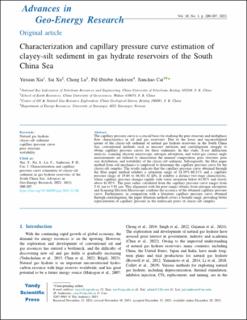| dc.contributor.author | Xia, Yuxuan | |
| dc.contributor.author | Xu, Sai | |
| dc.contributor.author | Lu, Cheng | |
| dc.contributor.author | Andersen, Pål Østebø | |
| dc.contributor.author | Cai, Jianchao | |
| dc.date.accessioned | 2024-02-23T11:38:06Z | |
| dc.date.available | 2024-02-23T11:38:06Z | |
| dc.date.created | 2023-12-21T10:44:09Z | |
| dc.date.issued | 2023 | |
| dc.identifier.citation | Xia, Y., Xu, S., Lu, C., Andersen, P. Ø., & Cai, J. (2023). Characterization and capillary pressure curve estimation of clayey-silt sediment in gas hydrate reservoirs of the South China Sea. Advances in Geo-Energy Research, 10(3), 200-207. | en_US |
| dc.identifier.issn | 2207-9963 | |
| dc.identifier.uri | https://hdl.handle.net/11250/3119610 | |
| dc.description.abstract | The capillary pressure curve is a crucial basis for studying the pore structure and multiphase flow characteristics in oil and gas reservoirs. Due to the loose and unconsolidated nature of the clayey-silt sediment of natural gas hydrate reservoirs in the South China Sea, conventional methods such as mercury intrusion and centrifugation struggle to obtain capillary pressure curves for these sediments. In this study, X-ray diffraction analysis, scanning electron microscopy, nitrogen adsorption, and water-gas contact angle measurements are utilized to characterize the mineral composition, pore structure, pore size distribution, and wettability of the clayey-silt sediment. Subsequently, the filter paper method from soil mechanics is employed to determine the capillary pressure curve for the clayey-silt samples. The results indicate that the capillary pressure curve obtained through the filter paper method exhibits a saturation range of 18.39%-80.31% and a capillary pressure range of 19.04 to 46,481.42 kPa. It exhibits a distinct two-stage characteristic, where capillary pressure changes rapidly with water saturation below 61.05% and slowly above 61.05%. The pore radius calculated from the capillary pressure curve ranges from 2.41 nm to 5.91 µm. This alignment with the pore ranges obtains from nitrogen adsorption and Scanning Electron Microscopy confirms the accuracy of the obtained capillary pressure curve. Furthermore, in comparison with a literature capillary pressure curve obtained through centrifugation, the paper filtration method covers a broader range, providing better representation of capillary pressure in the multiscale pores of clayey-silt samples. | en_US |
| dc.language.iso | eng | en_US |
| dc.publisher | Ausasia Science and Technology Press Pty. Ltd | en_US |
| dc.title | Characterization and capillary pressure curve estimation of clayey-silt sediment in gas hydrate reservoirs of the South China Sea | en_US |
| dc.type | Peer reviewed | en_US |
| dc.type | Journal article | en_US |
| dc.description.version | publishedVersion | en_US |
| dc.rights.holder | The authors | en_US |
| dc.subject.nsi | VDP::Teknologi: 500::Berg‑ og petroleumsfag: 510 | en_US |
| dc.source.pagenumber | 200-207 | en_US |
| dc.source.volume | 10 | en_US |
| dc.source.journal | Advances in Geo-Energy Research | en_US |
| dc.source.issue | 3 | en_US |
| dc.identifier.doi | 10.46690/ager.2023.12.06 | |
| dc.identifier.cristin | 2216767 | |
| dc.relation.project | Norges forskningsråd: 331644 | en_US |
| cristin.ispublished | true | |
| cristin.fulltext | original | |
| cristin.qualitycode | 1 | |
